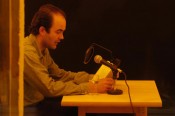“Translation is only impossible as any worthwhile enterprise is impossible: impossible to perform with the perfection that we desire. What translators must do, like modern knights errant, is to come as close as we can to the impossible goal,” John Rutherford writes in the introduction to his recent Penguin Classics translation of Don Quixote. This would seem the standard take on translation. Yet its paradox feels glib. Can translation survive deconstruction? How might translation be done once the fantasy of perfection has been relinquished?
Juan Cruz is translating Don Quijote (again), 2005, raised these questions and others besides. Over twenty-four days, Cruz sat in a back room at Peer, translating Cervantes’s novel aloud and “on the hoof” from the original Spanish into English, managing to finish the entire book by his deadline of November 6. (To his advantage, this was Cruz’s second attempt: In 1996 at London’s Instituto Cervantes, he spent two weeks working his way through the first third of the epic’s thousand-odd pages.) Cruz’s voice was audible on a single speaker in the main gallery. The artist himself was visible at his desk (along with a normally hidden array of back-room gallery clutter: pots, pans, dishcloths, empty wine bottles, etc.) through a small glazed window in the gallery wall. An orange gel on the glass served to pictorialize and distance the scene beyond. The arrangement recalled the painterly tradition of inset scenes – Velazquez’s use of windows to introduce sacred imagery into genre subjects, for example.
Cruz’s workplace hinted at various kinds of environment, some less salubrious than others: a radio broadcaster’s studio or a translator’s booth, but also a prison cell or (as Cruz himself has suggested) a peep show. Freely punctuated by repetitions, revisions, ums, ahs, and tantalizing silences, Cruz’s delivery frayed the novel’s already pleonastic story lines to the point of incomprehensibility, mutating the text into the rambling sound track of a thought process or even an esoteric act of self-pleasuring. Comparisons with Vito Acconci’s 1972 performance seedbed might be apt, and with them the question: for whose benefit was this seemingly solipsistic activity taking place? For all one knew, Cruz’s apparent absorption in his task could be a facade, maintained only as long as visitors remained in the gallery. Left alone, he might chuck the book aside and busy himself with something completely different. A press release stated that Cruz’s translation was being recorded, but this claim offered no guarantee of his diligence. After all, recordings can be made, stopped, and started at any time.
Critic Ian Hunt has identified “the sense of imperfect delivery, of imperfect transmission of ideas” as a key element in Cruz’s work, adding that this is a difficult subject for representation. However, in some theories of thinking, that’s a debatable notion: There are grounds for arguing that an idea can only be as perfect as its transmission. One might suppose that Cruz, plugging away at his desk, was privy to a richer experience of Cervantes’s text than his listeners. But reading aloud has an abstracting effect on language that almost always depletes rather than enhances the reader’s perception of meaning: the artist’s absorption of the novel’s content was probably just as discombobulated as that of his listeners. In a characteristically refined, subtle fashion, Cruz’s project troubled not just the fantasy of the perfect translation, but also the idea that, were one to peer into his mind, one might find there a more polished or nuanced version of Don Quixote than the one that fell so haltingly on listeners’ ears in the gallery.
Juan Cruz is translating Don Quijote (again), 2005, was staged at Peer, London, between 16 September and 6 November, 2005
Text © Rachel Withers and Artforum International 2006
Images © the artist and Peer, 2005
